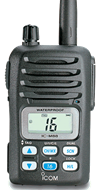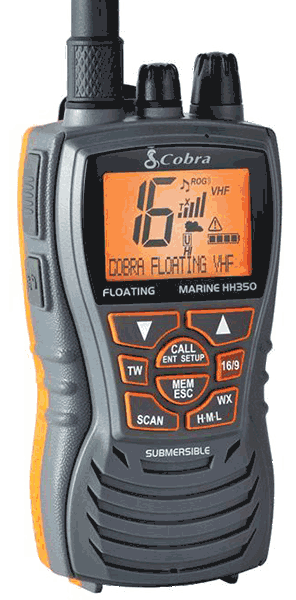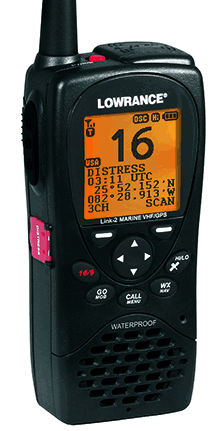Advertisement
A handheld VHF radio is a lifeline to the outside world — and today's units are better than ever before.

A portable VHF adds convenience and safety even if you already have a fixed set on board. (Photo: ThinkStock)
We trailer-boaters face a unique set of circumstances. We have the flexibility to go to distant places and launch into new, unexplored waters. Often this can be in remote areas or in places that are sparsely populated. As a result, cell service may be spotty. Even if it's not, you should never rely on a cellphone for emergency communications. In fact, no matter where you do your boating, the VHF radio is a primary tool for getting help. If your boat is large enough, you probably have a fixed-mount VHF. But you should still have a handheld in your emergency bag. Not only does it serve as a backup; it also allows you to take your most important communications device with you when you jump on someone else's boat or abandon yours. If your boat doesn't have a fixed-mount unit, carrying a handheld is a no-brainer. And whether you don't have a handheld VHF or have one that's more than five years old, the time to start shopping for a new one is right now. We've seen some significant design improvements recently, and today's models are far better than those made just a few short years ago.
Talk Is Cheap
Here's another bit of good news: Prices haven't gone up as handheld technology has improved. In fact, you can purchase reliable handheld VHFs for under $100. Even when you get all the bells and whistles, you'll have difficulty finding recreational-use models that creep much past $250 — a small price to pay for your safety.

Lowrance Link-2
This unit is a standout because it's one of the less expensive handhelds; a street price of around $175 is common. This VHF offers full DSC and GPS functionality and has a basic chartplotter mode as well as a nav screen. It's waterproofed to IPX7 standards, the 1,400-milliampere-hour battery is acceptable, and the unit floats. $199 | Lowrance.com
Icom IC-M88

This baby is only four inches tall, three inches wide, and weighs less than 10 ounces, so you can slip it right into a pocket. But that doesn't mean it's low on power: The IC-M88 packs a potent 1,700-milliampere-hour Li-ion battery. It doesn't have a bunch of fancy features, nor can it put out more than five watts, but thanks to an IPX7 rating, ultimate portability, and a power pack, this unit should be a must-see for many of us. $250 | IcomAmerica.com
Cobra MR HH350 FLT

This radio makes our list purely because of its price point. With a street price below $85, if you can afford a boat, you have no excuse for not having a handheld VHF radio on board. No, it's not the very cheapest around, but it's the least expensive unit that fulfills our basic requirement of waterproofing to an IPX7 standard. And although the 1,000-milliampere-hour battery is the weakest of these five presented units, the MR HH350 FLT puts out six watts, it floats, and it has a noise-cancelling microphone. $99 | Cobra.com
Standard-Horizon HX870

This unit has big-ticket features like DSC/GPS functionality, an IPX8 rating, a water-activated strobe (which will kick on even if the radio is turned off), and it floats. A real standout feature is the 1,800-milliampere-hour battery, the most powerful of all the VHFs on this list. At 11.36 ounces, it's also the heaviest handheld of the bunch we looked at, but that seems like a small price to pay for all the HX870 has to offer. $215 | StandardHorizon.com
Uniden MHS235/West Marine VHF460

Though it's pricy, this unit, which floats, has a long list of heavy-hitting features: an IPX8 rating, DSC functionality, a GPS compass, and a strobe, and it can transmit at one, two and a half, or six watts. The glow-in-the-dark power button and the temperature display are neat perks. The 1,160-milliampere-hour battery is on the thin side but should prove sufficient for most users. $250 | Uniden.com
What does the cash get you? For starters, you get waterproofing that's been tested to a set standard. Look for models with a JIS/IP waterproofing rating of 7 or higher. JIS (Japan Industrial Standard) and IP (International Protection, often seen as IPX, with the X indicating that the resistance rating doesn't apply to both water and solids) are reliable and very similar ratings applicable to marine electronics spanning a scale of 0 to 8. A level of 6 means the VHF has been tested and can withstand exposure to powerful water jets spraying 100 liters per minute for three minutes. But a rating of 7 means that the unit can withstand immersion under one meter of water for 30 minutes. And a rating of 8 means the radio survived immersion deeper than one meter. Obviously, this is quite desirable. Better yet, some new models aren't likely to ever become submerged — because they float. That's quite an advantage, especially for boaters who have butterfingers.
Another new feature we're seeing on a good number of handhelds these days is digital selective calling. The falling cost of miniaturized GPS receivers has allowed them to be incorporated into handhelds, which means that the moment the U.S. Coast Guard receives your communication, they know your exact position and identification. Plus, having a GPS built in allows for some basic navigational functions on many units.
Constant advances in lithium-ion batteries have also brought new abilities to handheld VHFs. (Buy only quality Li-ion batteries approved by known reliable manufacturers.) Li-ion batteries not only last longer and weigh less; the availability of additional power has also led many manufacturers to design radios that transmit at six watts. Five watts was traditionally the power limit for handhelds due to battery constraints. Although antenna height is the main limiting factor when it comes to a handheld's range, that extra wattage does allow you to shout out just a tiny bit louder, which could make all the difference in the world.
There are also a number of less significant but still important features that different handheld units offer. Most can be coupled with optional headsets and/or external speakers. Many have built-in flashlights or water-activated strobes. Some high-end units have noise-cancelling filters; some have recall features that allow you to replay the previous transmission in case it was a bit garbled or you just missed it.
Tip
Decisions, Decisions
Which handheld VHF unit is right for you? That's a tough call, and it's a decision only you can make. All five of the above units exemplify better choices, and each for unique reasons. If you go shopping for a handheld VHF in the near future, be sure to check these models out.
